Deployment Overview
This document describes how to set up multi-factor authentication (MFA) for Citrix Gateway with AuthPoint as an identity provider. Citrix Gateway must already be configured and deployed before you set up MFA with AuthPoint.
Citrix Gateway can be configured to support MFA in several modes. For this integration, we set up SAML with AuthPoint. To configure RADIUS authentication for Citrix Gateway, see Citrix Gateway RADIUS Integration with AuthPoint.
This integration was tested with NS13.1: Build 12.11.nc of Citrix ADC (Citrix Gateway is a part of Citrix ADC).
Citrix Gateway SAML Authentication Data Flow with AuthPoint
AuthPoint communicates with various cloud-based services and service providers with the SAML protocol. This diagram shows the data flow of an MFA transaction for a Citrix Gateway.
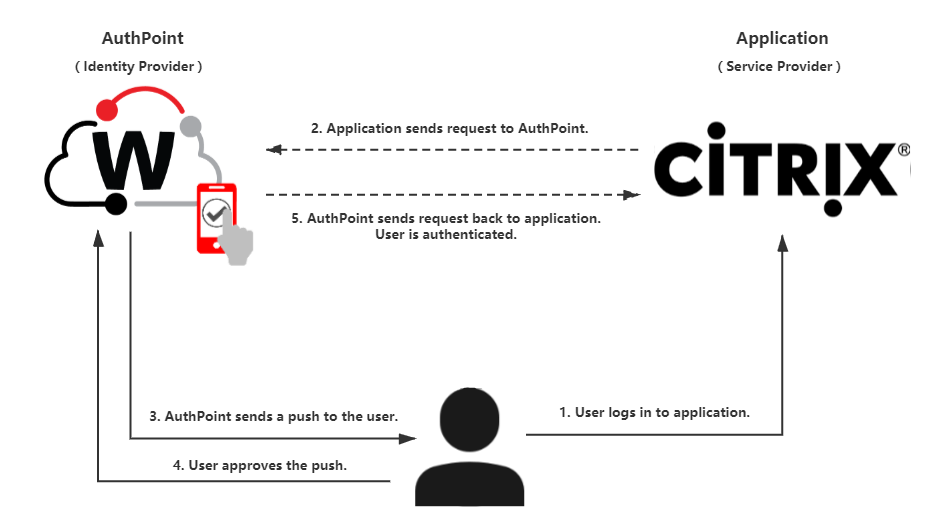
Before You Begin
Before you begin these procedures, make sure that:
- End-users able to configure Citrix ADC
- End-users able to login Citrix Gateway using local AD user
- Note: there needs many pre-requisites before integrating with AuthPoint. We suggest to refer to the configurtion of login Citrix Gateway using AD user, and make sure AD user could log in successfully. In that way we can confirm all the pre-setups on Citrix side are done before move to next step
- A token is assigned to a user in AuthPoint
- You have an AuthPoint identity provider (IdP) certificate (go to Certificate Management)
Configure Citrix Gateway
To start, you must download the metadata file and the certificate file from the Resources page in the AuthPoint management UI. Once you have those, you can configure Citrix Gateway.
From the WatchGuard Cloud web UI:
- From the navigation menu, select Configure > AuthPoint. If you have a Service Provider account, you must first pivot to your Subscriber view.
- Select Resources.
- Click Certificate.

- Next to AuthPoint certificate you will associate with your resource, click
 ,select Download Metadata and Download Certificate. We recommend that you choose the certificate with the latest expiration date. If you do not have a certificate, or if all of your certificates have expired, click Add Certificate and use the newly created certificate. For more information, see Certificate Management.
,select Download Metadata and Download Certificate. We recommend that you choose the certificate with the latest expiration date. If you do not have a certificate, or if all of your certificates have expired, click Add Certificate and use the newly created certificate. For more information, see Certificate Management.The AuthPoint metadata provides your resource, in this case Citrix Gateway, with information necessary to identify AuthPoint as a trusted identity provider.
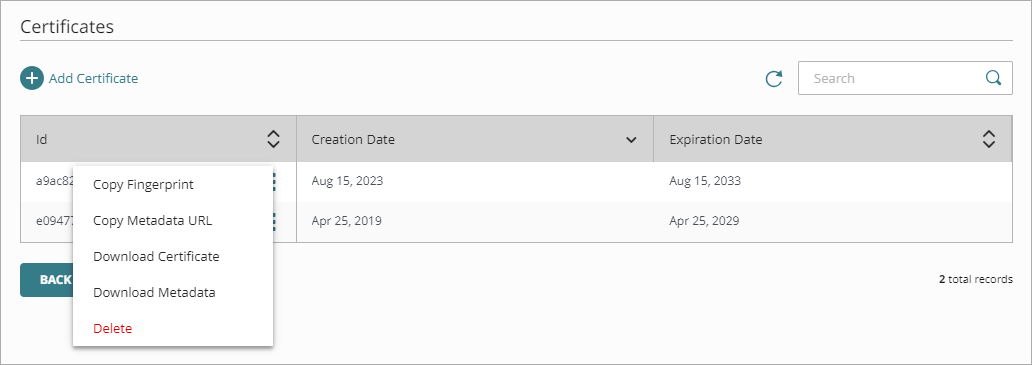
- Log in to the Citrix ADC admin interface as an administrator.
- Select the Configuration tab.
- Navigate to Traffic Management > SSL > Certificates > CA Certificates.

- Click Install.
- In the Certificate-Key Pair Name text box, type an easily identifiable name.
- For Certificate File Name, click Choose File and upload the CA certificate file you get.
- Click Install.


- Select Citrix Gateway > Policies > Authentication > SAML.
- Select the Servers tab.
- Click Add.
- In the Name text box, type an easily identifiable name. In our example, we type AuthPoint.
- Clear the Import Metadata check box.
- In the Redirect URL text box, type the SingleSignOnService Location value from the AuthPoint metadata file.
- In the Single Logout URL text box, type the SingleLogoutService Location value from the AuthPoint metadata file.
- From the SAML Binding drop-down list, select POST.
- From the Logout Binding drop-down list, select POST.
- From the IDP Certificate Name drop-down list, select the certificate you got from AuthPoint and installed to Citrix ADC.
- In the User Field text box, type Name ID.
- From the Signing Certificate Name drop-down list, select a certificate that can be trusted by Citrix.
- In the Issuer Name text box, type the name used to log in to the Citrix Gateway Virtual Server.
- From the Reject Unsigned Assertion drop-down list, select ON.
- For Signature Algorithm, select RSA-SHA256.
- For Digest Method, select SHA256.

- Click Create.

- On the SAML page, select the Policies tab. Click Add.

- In the Name text box, type an easily identifiable name. In our example, we type AuthPoint_Policy.
- From the Server drop-down list, select your SAML server.
- Under Expression, from the second Select drop-down list, select ns_true.

- Click Create.

If you get a warning about classic authentication policies, you can click OK to ignore it.

- Navigate to Citrix Gateway > Virtual Servers.
- Select the virtual servers you created. For more information about how to create virtual servers, see the Citrix documentation.
- Click Edit.
- Next to Basic Authentication, click +.
- From the Choose Policy drop-down list, select SAML.
- From the Choose Type drop-down list, select Primary.

- Click Continue.

- In the Select Policy section, click >.

- Select your SAML policy. Click Select.
- Leave the default settings.

- Click Bind.

- On the VPN Virtual Server configuration page, click Done.
- Navigate to Citrix Gateway > Policies > Authentication > SAML.
- Select the Servers tab.
- Select your SAML server and then click Export SAML Metadata.
- Select your VPN server and click Export.
- On the metadata page, find and copy the entityID, Assertion Consumer Service and SingleLogoutService values. You need these values to create a SAML resource in AuthPoint.
Configure AuthPoint
Before AuthPoint can receive authentication requests from Citrix Gateway, you must add a SAML resource in AuthPoint. You must also create an authentication policy for the Citrix Gateway resource to determine which users can authenticate and log in to Citrix Gateway and which authentication methods they can use (Push, QR code, and OTP).
Add a SAML Resource in AuthPoint
From the AuthPoint management UI:
- From the navigation menu, select Resources.
Click Add Resource.
The Add Resource page opens.

- From the Type drop-down list, select SAML.
Additional fields appear.

- On the SAML page, in the Name text box, type a name for this resource.
- From the Application Type drop-down list, select Citrix Gateway.
- In the Service Provider Entity ID text box, type the entityID value from the Citrix Gateway matadata page.
- In the Assertion Consumer Service text box, type the Assertion Consumer Service value from the Citrix Gateway matadata page. Format https://Citrix Gateway FQDN/cgi/samlauth.
- From the User ID sent on redirection to service provider drop-down list, select User Name.
- In the Logout URL text box, type the Assertion Consumer Service value from the Citrix Gateway matadata page. Format https://Citrix Gateway FQDN/cgi/tmlogout.
- From the Signature Method drop-down list, select SHA-256.
- From the AuthPoint Certificate drop-down list, select the certificate to associate with your resource. This must be the same certificate that you downloaded the metadata for in the previous section.
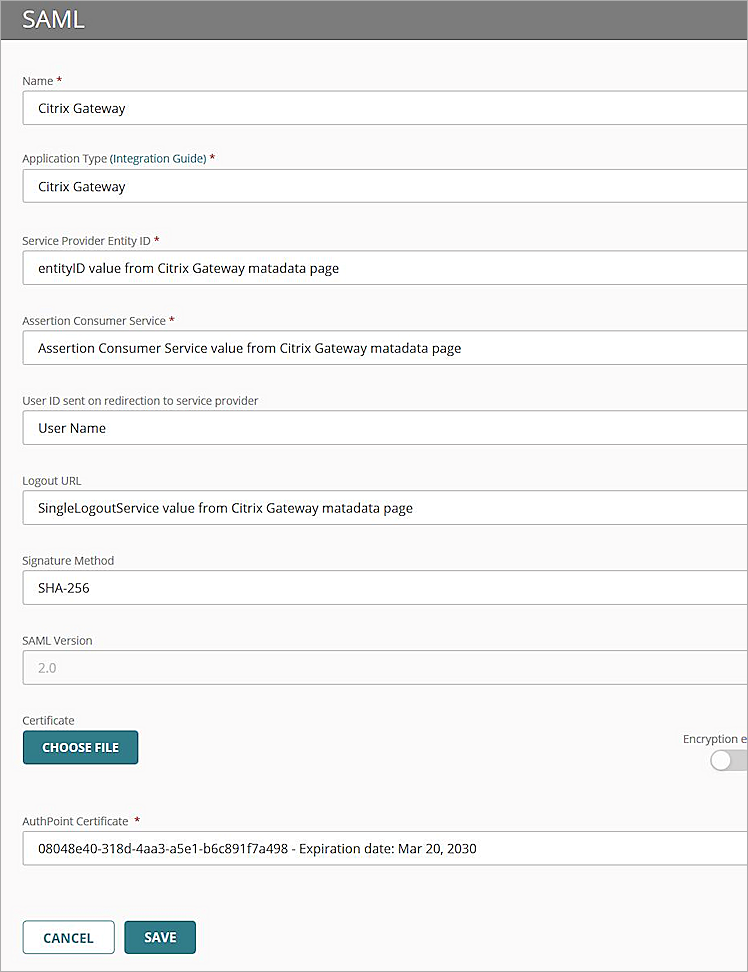
- Click Save.
Add a Group in AuthPoint
You must have at least one user group in AuthPoint to configure MFA. If you already have a group, you do not have to add another group.
To add a group to AuthPoint:
- From the navigation menu, select Groups.
- Click Add Group.
The New Group page appears.

- In the Name text box, type a descriptive name for the group.
- (Optional) In the Description text box, type a description of the group.
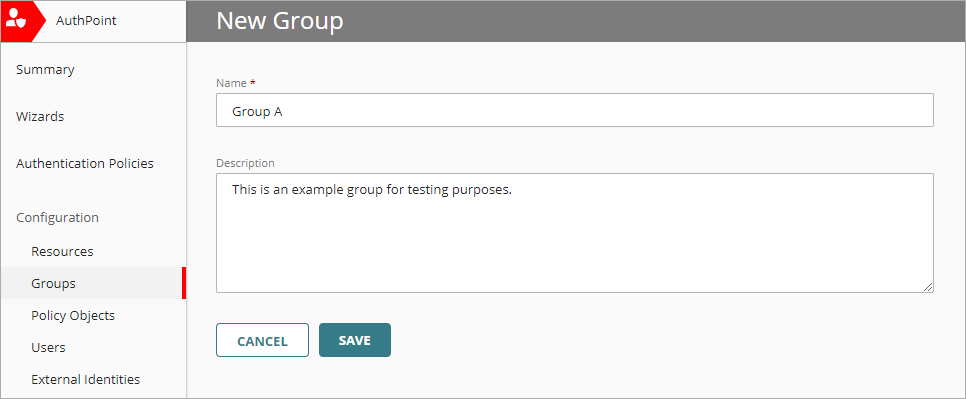
- Click Save.
Your group is listed on the Groups page.
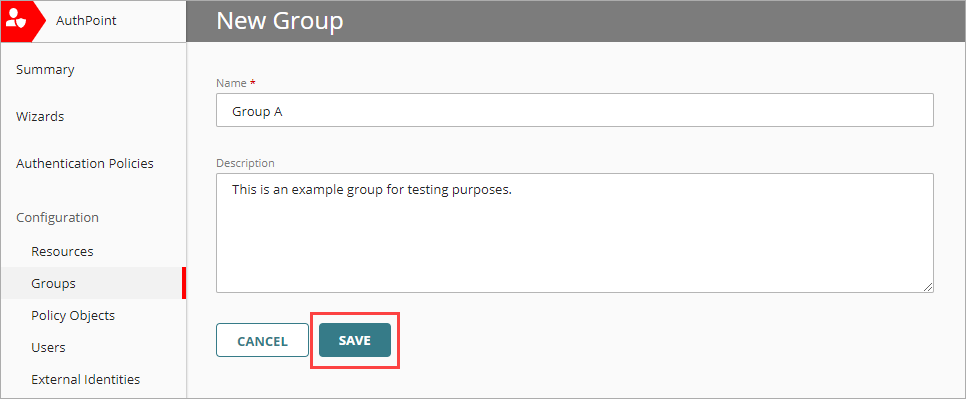
Add an Authentication Policy to AuthPoint
Authentication policies specify which resources users can authenticate to and which authentication methods they can use (Push, QR code, and OTP).
You must have at least one authentication policy in AuthPoint that includes the Citrix Gateway resource. If you already have authentication policies, you do not have to create a new authentication policy. You can add this resource to your existing authentication policies.
Users that do not have an authentication policy for a specific resource cannot authenticate to log in to that resource.
To configure an authentication policy:
- From the navigation menu, select Authentication Policies.
- Click Add Policy.

- Type a name for this policy.
- From the Select the authentication options drop-down list, select Authentication options and select which authentication options users can choose from when they authenticate.
For SAML resources, if you select more than one authentication option, users must select one of the available options when they authenticate. For example, if you select OTP and Push, users can choose to type their OTP or approve a push to authenticate. You cannot require that they do both.
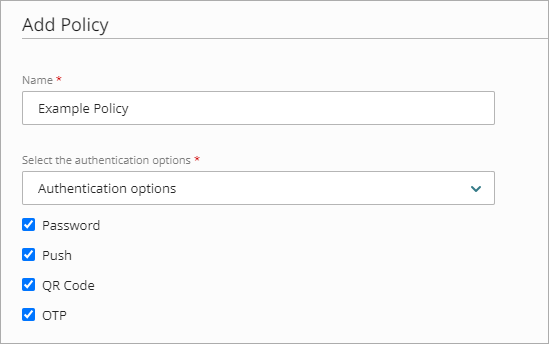
- Select which groups this policy applies to. You can select more than one group. To configure this policy to apply to all groups, select All Groups.
- Select the resource that you created in the previous section. If you want this policy to apply to additional resources, select each resource this policy applies to. To configure this policy to apply to all resources, select All Resources.

-
(Optional) If you have configured policy objects such as a Network Location, select which policy objects apply to this policy. When you add a policy object to a policy, the policy only applies to user authentications that are the same as the conditions of the policy objects. For example, if you add a Network Location to a policy, the policy only applies to user authentications that come from that Network Location. Users who only have a policy that includes a Network Location do not get access to the resource when they authenticate outside of that Network Location (because they do not have a policy that applies, not because authentication is denied).
If you configure policy objects, we recommend that you create a second policy for the same groups and resources without the policy objects. The policy with the policy objects should have a higher priority.

- Click Save.
Your policy is created and added to the end of the policy list.When you create a new policy, we recommend that you review the order of your policies. AuthPoint always adds new policies to the end of the policy list.
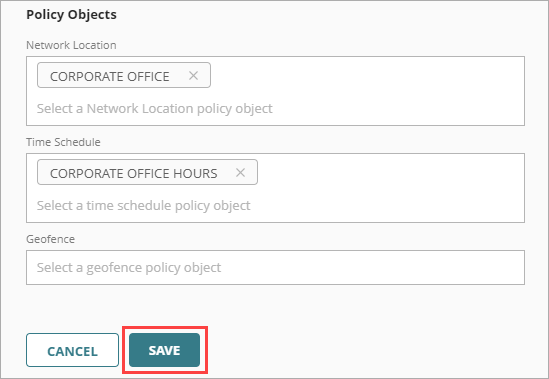
Before you assign users to a group, you must add the users to AuthPoint. You can manually add user accounts or import user accounts from an external user database. For more information on how to add user accounts, see Add User Accounts.
Test the Integration
To test the integration of AuthPoint and the configuration of Citrix Gateway, you can authenticate with a mobile token on your mobile device. You can choose any method (one-time password, QR code, or push).
In this example, we show the push authentication method (users receive a push notification in the mobile app that they must approve to authenticate).
- In a web browser, go to the Citrix Gateway virtual server login URL.
You see the AuthPoint authentication page. - Type your email address or AuthPoint user name. Click Next.
- If required, in the Password text box, type your password.
- For the authentication method, select Send Push.
- Approve the authentication request that is sent to your mobile device.
You are logged in to Citrix Gateway virtual server.
When you log in, the Citrix Gateway UI appears empty because there are no products bound after Citrix Gateway. You can bind Citrix Gateway with other Citrix products, such as XenApp and XenDesktop.
